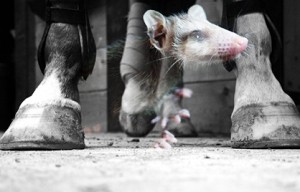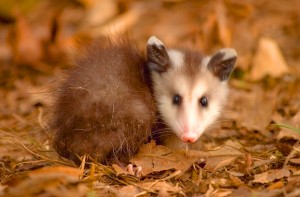
Playing Possum is No Laughing Matter When it Comes to Horses
By: Brittany Bevis
By now, chances are you’ve seen the widely circulated video and photos of Triple Crown contender, California Chrome, facing off against an unusual opponent on the race track. During one of his morning workouts last week at the Belmont, Chrome met up with a stray opossum that darted on to the track.
Thanks to the considerable media presence that was there to witness Chrome’s warmup, photos and videos of the encounter have flooded social media. We have to admit that Robert Sabo’s photograph for the New York Daily News that captured the jockey’s reaction is priceless…
While the encounter made for some clever jokes and entertaining articles (the opossum even has his own Twitter account), many horse owners will agree that a meeting between a horse and an opossum is no laughing matter.
To help clear up some of the myths and facts associated with this four-legged marsupial, we sought the expertise of Dr. Nicola Pusterla, Professor of Medicine and Epidemiology at UC Davis. Recognized as one of the world’s experts in epidemiology and equine infectious diseases, Pusterla’s work was instrumental during the EHV-1 outbreak in 2011-2012. Currently, his research topics include equine influenza, equine coronavirus (ECoV), and equine protozoal myeloencephalitis. Of specific interest for this article is the latter, EPM, the host of which is the opossum.
EC.com– What are some of the dangers associated with horse-opossum contact, in addition to EPM infection? Rabies, bites, ect.?
Dr. Nicola Pusterla– “You mentioned the most important ones, which are shedding of Sarcocystis neurona [the protozoa that causes EPM] in the scat of opossum and bite wounds. Overall, the yearly number of opossums diagnosed with rabies is very low, definitively lower than in the main reservoirs (raccoon, fox, bat, skunk). Opossum also carry some rickettsial pathogens, which are of greater concern to humans than horses.”
EC.com– What are good methods of preventing horse-opossum contact?
Dr. Nicola Pusterla- “Use non-climb fencing with electric wire to prevent access of opossum to pastures. Secure horse feed, which will minimize contamination. Good rodent control and not leaving feed (cat or dog feed) in the barn will prevent attracting hungry opossums.”
EC.com- What are basic EPM symptoms horse owners should look out for?
Dr. Nicola Pusterla– “EPM can mimic most neurological disorders. The so called typical presentation is characterized by progressive ataxia (incoordination), placement abnormalities, and muscle waisting. One of the key signatures of EPM is that it causes asymmetrical signs.”
EC.com– If someone suspects their horse has come into contact with an opossum, or contracted EPM, what should they do?
Dr. Nicola Pusterla– “Talk to your veterinarian. One must consider that less than 1/10,000 exposed to S. neurona may end up developing EPM. I look at the opossum-horse interaction as an occupational hazard of being a horse. However, minimizing risk factors (stress, interaction with wildlife, young age, high level of exercise) is key in reducing the likelihood of a horse to develop EPM. Serological testing in blood and cerebrospinal fluid can help support the diagnosis of EPM in a horse with compatible clinical signs.”
EC.com– What is the biggest myth associated with opossums and contact with horses?
Dr. Nicola Pusterla– “Not sure about this one, what about an opossum winning the Belmont race?…”
Although it is important to prevent contact between horses and opossums, Dr. Pusterla would like to note that the animal does have an important ecological role, in cleaning up dead animal carcasses and providing food for animals higher up in the food chain. Just keep them away from your barns… and the racetrack on Belmont day.

Recently Added
- Around the Rings – 2025 Dixie National Quarter Horse Show February 19, 2025
- EC Photo of the Day – Wishes for You February 19, 2025
- Appaloosa Youth Association Springtime Equine Care Seminar February 19, 2025
- EC Photo of the Day – All Our Dreams February 18, 2025
- EC Foal Photo of the Day – Baby’s First Snow Day! February 17, 2025
- Stock Horse Events Are On The Rise In Texas February 17, 2025
- Around the Rings – 2025 SCQHA Premier Cattle Classic February 17, 2025
- EC Photo of the Day – The Simplest Form of Gratitude February 16, 2025
- EC Photo of the Day – Catching Snowflakes on Your Tongue February 15, 2025
- EC Photos of the Day – A Love Poem in Honor of Your Horse February 14, 2025
Archives
Sign In
Equine Chronicle ® All Rights Reserved. Copyright © 2025
4727 NW 80th Ave. • Ocala, FL 34482 • 352 369 1104 • FAX 352 369 1521
Privacy Policy | Questions, please contact The Equine Chronicle
-










